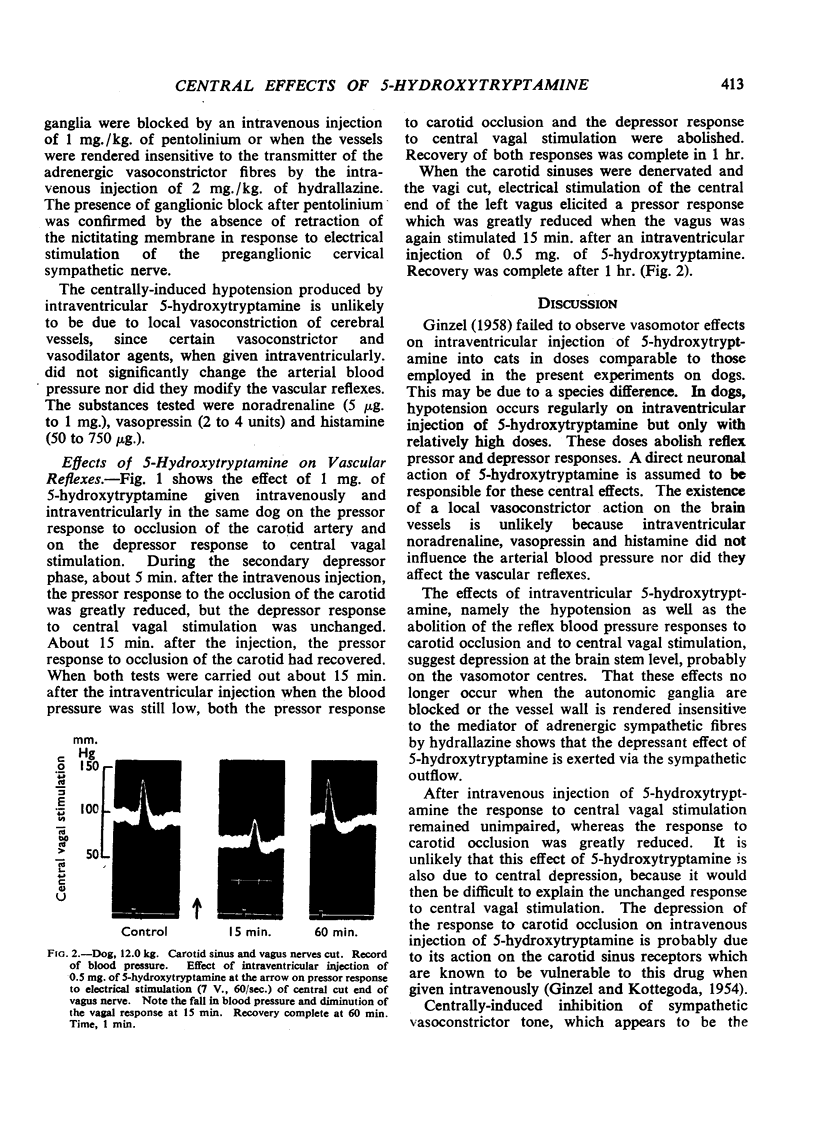Abstract
In the dog, injection of 5-hydroxytryptamine into the cerebral ventricles caused hypotension, inhibition of the pressor response to occlusion of the carotid artery and inhibition of the pressor or depressor response evoked by electrical stimulation of the central end of the cut vagus. Hypotension and inhibition of the vagal vasomotor response also occurred in dogs in which the carotid sinuses had been denervated and the vagi cut. The site of action was central. Local cerebral vascular changes could not have been responsible for the action. The central vasomotor effects of 5-hydroxytryptamine are mediated through the sympathetic outflow. Implications of these findings are discussed in relation to the effects of intravenous 5-hydroxytryptamine and the mechanism of action of reserpine.
Full text
PDF



Selected References
These references are in PubMed. This may not be the complete list of references from this article.
- BHARGAVA K. P., BORISON H. L. Comparative effects of various Rauwolfia alkaloids on centrally evoked vasopressor responses. J Pharmacol Exp Ther. 1957 Mar;119(3):395–405. [PubMed] [Google Scholar]
- FELDBERG W., SHERWOOD S. L. Injections of drugs into the lateral ventricle of the cat. J Physiol. 1954 Jan;123(1):148–167. doi: 10.1113/jphysiol.1954.sp005040. [DOI] [PMC free article] [PubMed] [Google Scholar]
- GINZEL K. H., KOTTEGODA S. R. The action of 5-hydroxytryptamine and tryptamine on aortic and carotid sinus receptors in the cat. J Physiol. 1954 Feb 26;123(2):277–288. doi: 10.1113/jphysiol.1954.sp005050. [DOI] [PMC free article] [PubMed] [Google Scholar]
- GINZEL K. H. The effect of (+)-lysergic acid diethylamide and other drugs on the carotid sinus reflex. Br J Pharmacol Chemother. 1958 Sep;13(3):250–259. doi: 10.1111/j.1476-5381.1958.tb00899.x. [DOI] [PMC free article] [PubMed] [Google Scholar]
- MARRAZZI A. S., HART E. R. Relationship of hallucinogens to adrenergic cerebral neurohumors. Science. 1955 Mar 11;121(3141):365–367. doi: 10.1126/science.121.3141.365. [DOI] [PubMed] [Google Scholar]
- PLETSCHER A., SHORE P. A., BRODIE B. B. Serotonin as a mediator of reserpine action in brain. J Pharmacol Exp Ther. 1956 Jan;116(1):84–89. [PubMed] [Google Scholar]
- REID G. Circulatory effects of 5-hydroxytryptamine. J Physiol. 1952 Dec;118(4):435–453. doi: 10.1113/jphysiol.1952.sp004806. [DOI] [PMC free article] [PubMed] [Google Scholar]
- SHORE P. A., PLETSCHER A., TOMICH E. G., CARLSSON A., KUNTZMAN R., BRODIE B. B. Role of brain serotonin in reserpine action. Ann N Y Acad Sci. 1957 Mar 14;66(3):609-15; discussion, 615-7. doi: 10.1111/j.1749-6632.1957.tb40751.x. [DOI] [PubMed] [Google Scholar]
- SHORE P. A., SILVER S. L., BRODIE B. B. Interaction of serotonin and lysergic acid diethylamide (LSD) in the central nervous system. Experientia. 1955 Jul 15;11(7):272–273. doi: 10.1007/BF02161252. [DOI] [PubMed] [Google Scholar]


